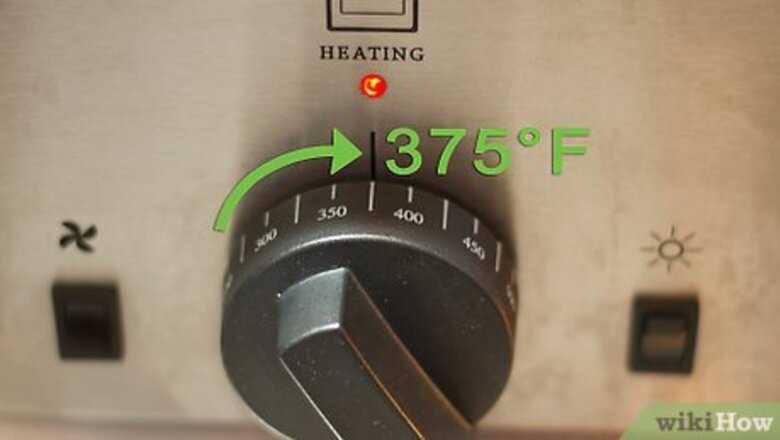
views
Cleaning Cast Iron

Preheat the oven to 375 °F (191 °C). Let your oven warm up while you’re busy preparing the pan. You can use it to finish drying the cast iron in addition to seasoning it. However, make sure it doesn’t get too hot, or else it could overheat the cast iron and even burn the oil used for seasoning later. Any temperature from 350 to 400 °F (177 to 204 °C) is fine, so you won’t have a problem even if your oven isn’t precise.
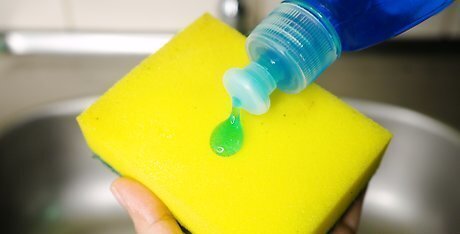
Use a sponge to thoroughly scrub the cast iron with soapy water. Pour about 1 tablespoon (15 mL) of your regular dish detergent onto the cast iron. Run hot water in your sink, then scrub the cast iron all over with a sponge. Eliminate any noticeable debris on the surface so it doesn’t get in the way of the oil coating used for seasoning. Focus on the inner part of the item, but don’t neglect the outer part. It too needs to be seasoned. To remove stubborn debris, scrub the cast iron with a nylon kitchen brush or a nonabrasive scrub pad. Avoid anything that could potentially leave scratches in the metal.
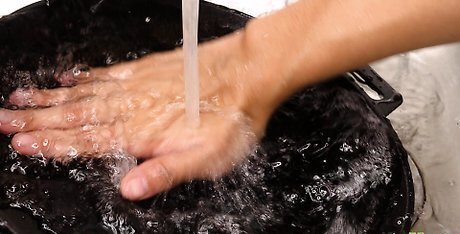
Rinse the cast iron with clean water. Wash off all of the soap and any debris. Once it is clean, dry it with a clean cloth or paper towel. Remove as much of the moisture as you can. Any water left on cast iron long-term can cause it to rust. Normally, using lots of water is bad for cast iron. Since you’re going to dry and season your right away, washing it clean is safe.
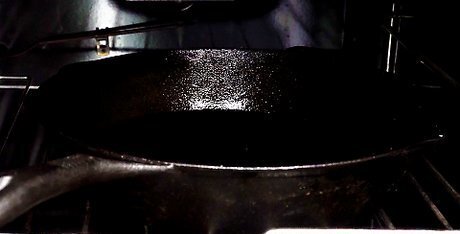
Put the cast iron in the oven for 5-10 minutes to remove all moisture. Place the cast iron on the middle rack in your oven. If it doesn’t have a middle rack, you can use a higher one instead. Set a timer and come back afterward to take the item out of the oven. Preheating the cast iron removes any remaining moisture on it and helps the oil coating spread more evenly. You can effectively season cast iron without doing this, but it’s a short step that improves the final result.
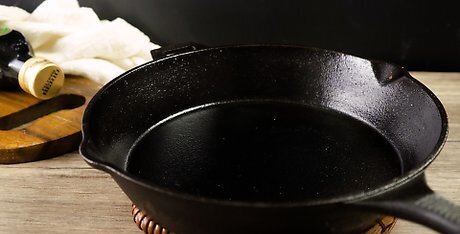
Set the cast iron on a heat-safe surface after taking it out of the oven. Since it wasn’t in the oven for long, the cast iron won’t be extremely hot. However, it can still cause damage, so be careful when handling it. Pull it out with an oven mitt, then set it somewhere safe, such as your stovetop. In most cases, you won’t have to wait for the cast iron to cool before seasoning it. Place your hand near it to detect any heat coming off of it. If it feels too hot to handle, give it 2 to 3 minutes to cool. Keep in mind that the heat of the cast iron will vary depending on how hot your oven gets and what temperature you set it to earlier. Every oven is a little different.
Oiling the Cast Iron

Pour about 1 tablespoon (15 mL) of vegetable oil onto the cast iron. Add the oil, then tip the cast iron from side to side to spread it around. Make sure the entire surface is well-coated with the oil. Depending on the size of the piece you’re seasoning, you may need to add a little extra oil to finish coating it. If you don’t have vegetable oil, canola oil, lard, shortening, flax oil, and even bacon grease are also safe to use. As long as you use something oily that resists moderate heat, you can season cast iron with it.
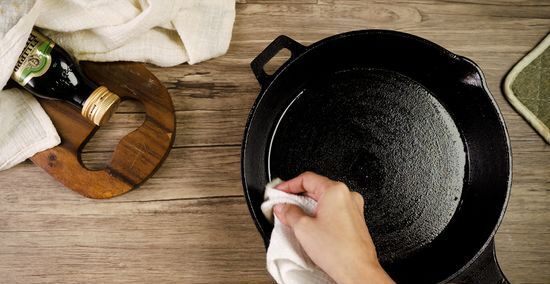
Spread the oil around the inside of the cast iron with a clean cloth. Rub the oil all over the inside of your item, including around the sides and rim. Make sure the oil forms a thin, consistent layer over the entire interior portion of the item. When you’re done spreading it around, wipe the cast iron down with a clean part of the rag to remove any excess oil still in it. Even if the cast iron looks dry, wipe it down. There is always a little extra oil left on the surface, and it will drip off into your oven if it isn’t removed now.
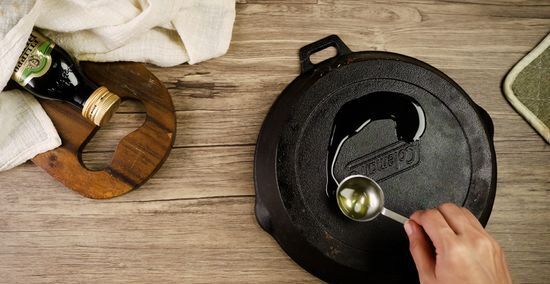
Flip the cast iron and spread 1 tablespoon (15 mL) of oil around its exterior. The exterior portion also benefits from seasoning. Pour the oil over the item, then use a cloth to rub it in. Keep applying more oil as needed to cover the entire exterior in a thin but consistent coating. Wipe off the excess when you’re done. Remember to get the handle in addition to the sides and bottom portion of your item. These spots will rust too if they aren’t well-maintained.
Heating Cast Iron in an Oven
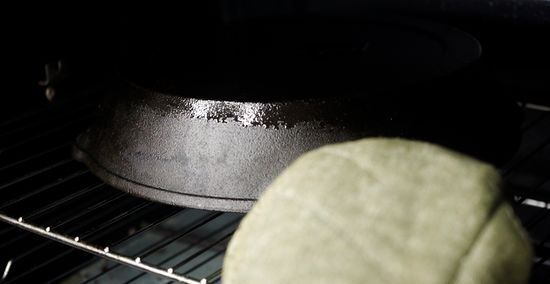
Place the cast iron upside down on your oven’s middle rack. Be careful, since your oven will still be hot from earlier. Wear an oven mitt when sliding the cast iron into the middle part of your oven. If you don’t have a middle rack, you can put the cast iron on a higher rack. Leave plenty of space near the bottom of the oven for another pan or at least a rack with aluminum foil over it.
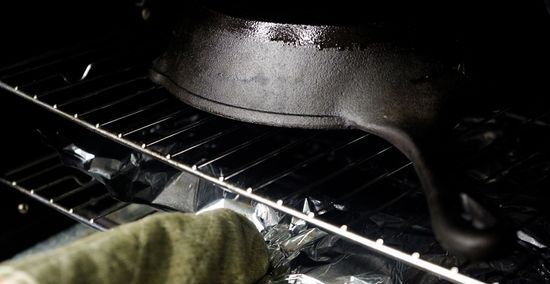
Fit a piece of aluminum foil underneath the cast iron on the bottom rack. The sheet of foil is there to catch any oil dripping off the pot. If it falls onto the heating element, it could begin to smoke or burn. You could also use another pan, such as a baking tray, to catch the oil. If you spread the oil in a thin enough layer, little to no oil will fall from it. Still, place something underneath the cast iron for safety.
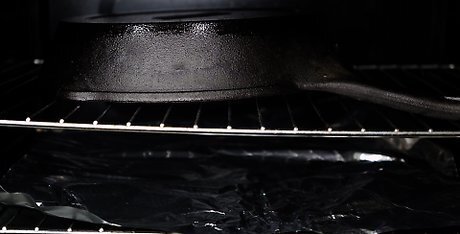
Bake the cast iron in the oven for 1 hour. Set a timer and wait as the cast iron heats up. It will get very hot during this time, but not hot enough for the oil to burn. Instead, the oil will bake into the cast iron to form a protective non-stick surface. Watch for any signs of smoking, sizzling oil. If you notice any issues, turn off the oven and let it cool down. Soak up any spilled oil with a paper towel.
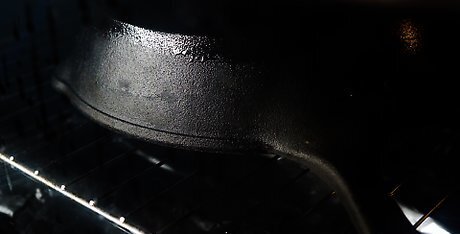
Turn off the oven and let the cast iron cool for 2 to 3 hours. It will be very hot, so don’t rush to take it out. After several hours have passed, open the oven door and put your hand close to the cast iron. If you feel a lot of heat coming off of it, leave it to cool for a little longer. Otherwise, you can begin using it right away. If the cast iron is still a little warm, be sure to put it on a heat-safe surface, such as your stovetop. You can season cast iron multiple times by applying more oil. Once is enough for most pieces of cast iron, but seasoning repeatedly leads to a stronger, thicker non-stick coating.
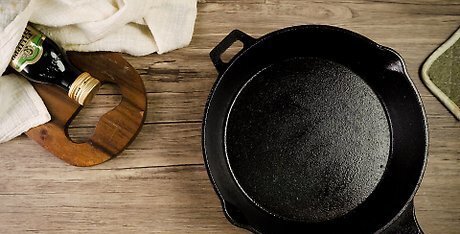
Clean and store cast iron in a dry spot after using it. Once cast iron is well-seasoned, you can use it to cook almost anything, from meats to desserts. If you aren't using it immediately, put the cast iron safe in a moisture-free spot with good air circulation. It can be left out on your countertop, stovetop, or placed in the oven, for instance. If it has a lid, place a paper towel underneath the lid so air can get it. After cooking with your cast iron, wait for it to cool down. While it’s slightly warm, clear off any debris with a little bit of soap, warm water, and a sponge or soft-bristled brush. Apply the fresh layer of oil with a cloth or paper towel, then wipe off the excess. You could also heat the cast iron at about 200 °F (93 °C) for 15 to 20 minutes to further bake in the oil. After drying it, cover it with another coating of oil to keep it well-seasoned.



















Comments
0 comment